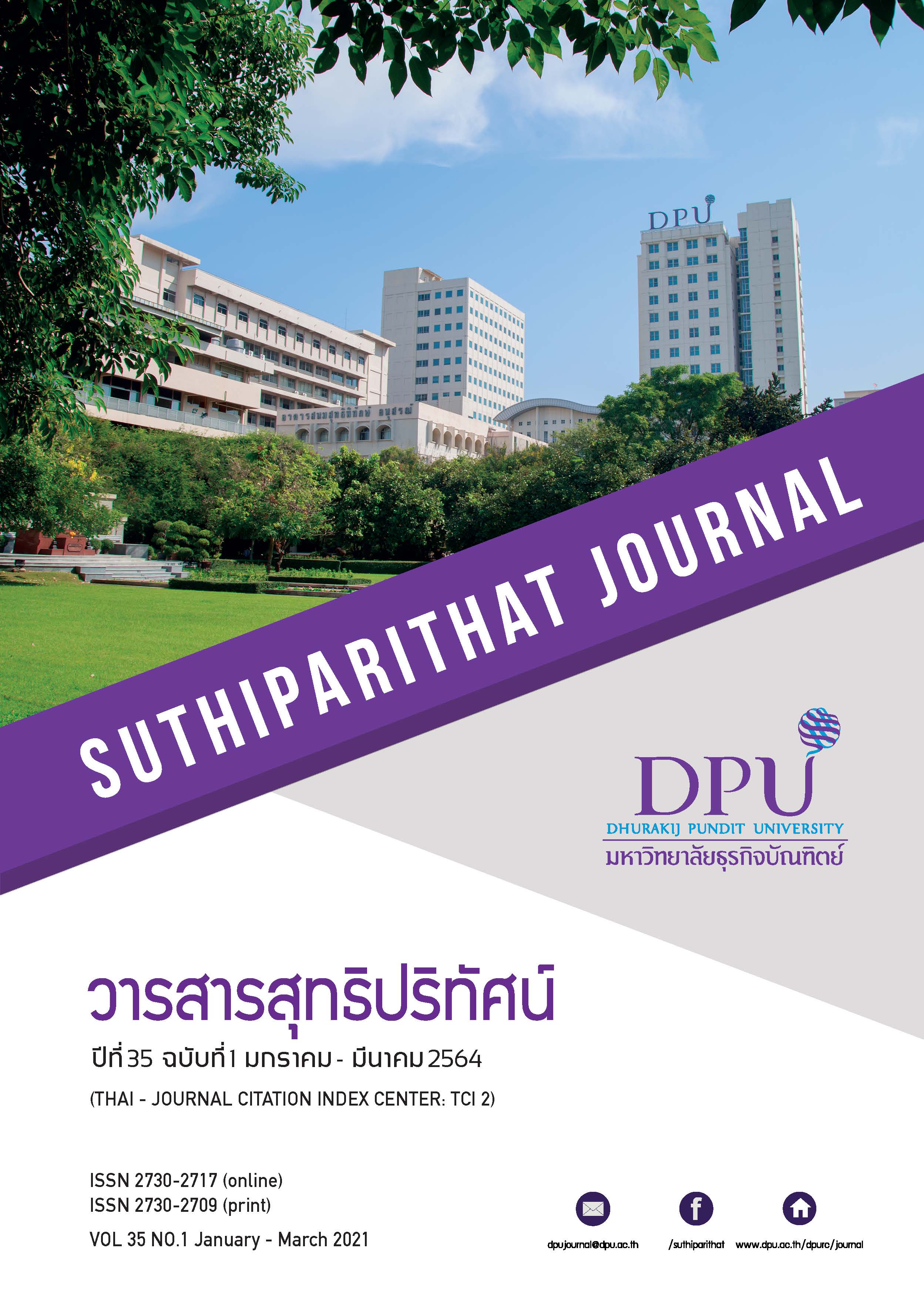อิทธิพลของลักษณะพื้นฐานของบริษัทที่จดทะเบียนในตลาดหลักทรัพย์แห่งประเทศไทยต่ออันดับความน่าเชื่อถือครั้งแรกของตราสารหนี้
คำสำคัญ:
อันดับความน่าเชื่อถือ, ตราสารหนี้, คุณลักษณะพื้นฐานบทคัดย่อ
การวิจัยครั้งนี้มีวัตถุประสงค์เพื่อ ศึกษาความสัมพันธ์ระหว่างคุณลักษณะพื้นฐานของบริษัท คุณภาพกำไร และอันดับความน่าเชื่อถือครั้งแรกของตราสารหนี้ และอิทธิพลของคุณลักษณะพื้นฐานของบริษัทต่ออันดับความน่าเชื่อถือครั้งแรกของตราสารหนี้ผ่านคุณภาพกำไร ด้วยวิธีวิจัยเชิงปริมาณ กลุ่มตัวอย่างเป็นบริษัทในตลาดหลักทรัพย์แห่งประเทศไทย ที่เสนอเข้ารับการประเมินขอจัดอันดับความน่าเชื่อถือของตราสารหนี้เป็นครั้งแรก จัดเก็บข้อมูลจากงบการเงินเป็นระยะเวลา 7 ปี ตั้งแต่ พ.ศ. 2555 ถึง พ.ศ. 2561 ข้อมูลดังกล่าวจะนำมาวิเคราะห์โมเดลสมการโครงสร้าง (Structural Equation Model: SEM)
ผลการศึกษาวิจัย พบว่า ผลการพัฒนารูปแบบความสัมพันธ์เชิงสาเหตุของคุณลักษณะพื้นฐานบริษัทด้านขนาดของบริษัท ด้านความสามารถในการทำกำไร ด้านความเสี่ยงทางการเงิน และด้านกระแสเงินสดจากการดำเนินงาน เป็นไปตามรูปแบบความสัมพันธ์เชิงสาเหตุแบบจำลองสมการที่ผู้วิจัยพัฒนาขึ้น มีความเหมาะสมสอดคล้องกับข้อมูลเชิงประจักษ์ และคุณลักษณะพื้นฐานบริษัทดังกล่าวมีอิทธิพลต่ออันดับความน่าเชื่อครั้งแรกของตราสารหนี้ผ่านคุณภาพกำไรอย่างมีนัยสำคัญทางสถิติ ณ ระดับ 0.05
References
ศรายุทธ เรืองสุวรรณ, และสุภาวินี จีวะสุวรรณ. (2562). ภูมิทัศน์ของการบิดเบือนงบการเงินของบริษัทจดทะเบียนไทย. วารสารวิชาชีพบัญชี, 15(48), 31-51.
สมาคมตราสารหนี้ไทย. (2562). 10-year challenge ของตลาดตราสารหนี้. สืบค้น พฤศจิกายน 2563, จาก http://www.thaibma.or.th.
Al-Fayoumi, N., Abuzayed, B., & Alexander, D. (2010). Ownership structure and earnings management in emerging markets: The case of Jordan. International Research Journal of Finance and Economics, 38, 28-47.
Ardison, K. M. M., Martinez, A. L., & Galdi, F. C. (2012). The effect of leverage on earnings management in Brazil. Advance in Scientific and Applied Accounting, 5(3), 305–324.
Charitou, A., Lambertides, N., & Trigeorgis. (2011). Distress risk, growth and earnings quality. A Journal of Accounting, Finance and Business Studies, 47(2), 158-181.
Davison, R., Goodwin-Stewart, J., & Kent, P. (2005). Internal governance structures and earning management. Accounting and Finance, 45(2), 241-267.
Dechow, P. M., Ge, W., Larson, C. R., & Sloan, R. G. (2011). Predicting material accounting misstatements. Contemporary Accounting Research, 28(1), 17-82.
Defond, M. L., & Jiambalvo, J. (1994). Debt covenant violations and manipulation of accruals. Journal of Accounting and Economics, 17(1-2), 145-176.
Demirtas, K. O., & Cornaggia, K. R. (2013). Initial credit ratings and earnings management. Review of Financial Economics, 135-145.
Ederington, L. H., Yawitz, J. B., & Roberts, B. E. (1987). The information content of bond. Journal of Financial Research, 10, 211-226.
Flannery, M., & Rangan, K. (2006). Partial adjustment toward target capital structures. Journal of Financial Economics, 79, 469-506.
Ghosh, A., & D. Moon. (2010). Corporate debt financing and earnings quality. Journal of Business Finance & Accounting, 37(5-6), 538-559.
Gong, Guojin, Louis, Henock, & Sun, Amy X. (2008). Earnings management and firm performance following open-market repurchases. Journal of Finance, 63(2), 947–986.
Hovakimian, A, Hovakimian, G., & Tehranian, H. (2004). Determinants of target capital structure: the case of dual debt and equity issues. Journal of Financial Economics, 71(3), 517-540.
John, Kose, Lynch, Anthony W., & Puri, Manju. (2003). Credit ratings and loan characteristics: Implications for yield. Journal of Business, 76(3), 371-409.
Kaplan, Robert S., & Urwitz, Gabriel. (1979). Statistical models of bond ratings: A methodological inquiry. Journal of Business, 52(2), 231-261.
Leuz, C., Nanda, D., & Wysocki, P. D. (2003). Earning management and investor protection: an international comparison. Journal of Financial Economic, 69(3), 505-527.
Liu, J., Uchida, K., & Gao, R. (2011). Capital structure and earnings management of IPO companies: Evidence from China. In the 19th Conference on the Theories and Practices of Securities and Financial Markets. Kaohsiung: National Sun Yat-Sen University.
Liu, Y., Y. Ning, & W. N. Davidson III. (2010). Earnings management surrounding new debt issues. The Financial Review, 45(3), 659-681.
Nguyen, V. T., & Li, Xu. (2010). The impact of dual class structure on earnings management activities. Journal of Business Finance & Accounting, 37(3-4), 456-485.
Rajan, R. G., & Zingales, L. (1995). What do I know about capital structure? Some evidence from international data. Journal of Finance, 50, 1421-1460.
Roychowdhury, S. (2006). Earnings management through real activities manipulation. Journal of Accounting and Economics, 42, 335.
Sengupta, P. (1998). Corporate disclosure quality and the cost of debt. The Accounting Review, 73, 459-474.
Zamri, N., Rahman. R. A., & Isa, N. S. M. (2013). The impact of leverage on real earnings management. Procedia Economics and Finance, 7, 86–95.
Zhang, Z., & Liu, X. (2009). The effects of capital structure on earnings management: Empirical evidence from China. In the 1st International Conference on Information Science and Engineering. Nanjing: Nanjing University of Science and Technology.
Downloads
เผยแพร่แล้ว
How to Cite
ฉบับ
บท
License
เนื้อหาและข้อมูลในบทความที่ลงตีพิมพ์ในวารสารสุทธิปริทัศน์ ถือเป็นข้อคิดเห็นและความรับผิดชอบของผู้เขียนบทความโดยตรงซึ่งกองบรรณาธิการวารสาร ไม่จำเป็นต้องเห็นด้วย หรือร่วมรับผิดชอบใดๆ
บทความ ข้อมูล เนื้อหา รูปภาพ ฯลฯ ที่ได้รับการตีพิมพ์ในวารสารสุทธิปริทัศน์ ถือเป็นลิขสิทธิ์ของวารสารสุทธิปริทัศน์หากบุคคลหรือหน่วยงานใดต้องการนำทั้งหมดหรือส่วนหนึ่งส่วนใดไปเผยแพร่ต่อหรือเพื่อกระทำการใด ๆ จะต้องได้รับอนุญาตเป็นลายลักษณ์อักษรจากวารสารสุทธิปริทัศน์ก่อนเท่านั้น







